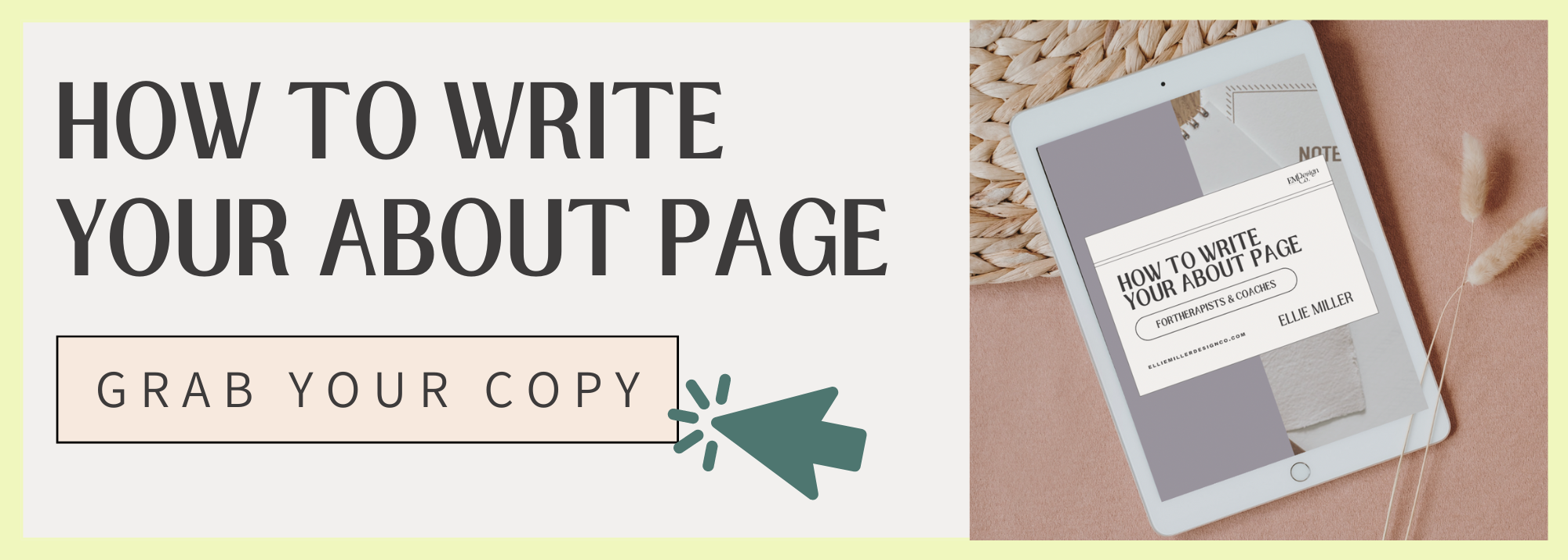How to Write Your Therapist Bio (with examples!)
If you’re looking to write a therapist bio that truly connects with potential clients, you’ve come to the right place. Your bio is often the first handshake, the first smile—virtually, of course! It’s where you get to say, “Hey, I’m here for you.”
Let’s make sure it really sings, shall we?
Why Your Therapist Bio is Super Important
Let’s kick things off by talking about why your bio is such a big deal. This little snippet of text is your chance to make a great first impression. It’s where potential clients decide if you’re the right fit for them. Think of it as your virtual handshake. You want it to be warm, welcoming, and genuine.
5 Benefits of a Great Therapist Bio
Feel More Legit (Even If You're New or Struggling with Imposter Syndrome)
Your bio helps potential clients trust you by showing warmth, clarity, and expertise—even if you’re still figuring out how to talk about what you do.Make a Real Connection Before You Even Meet
When your bio shares a bit of your story, your values, or why you do this work, it helps the right clients feel seen—and more comfortable reaching out.Stand Out Without Feeling Like You're Bragging
You don’t need to “sell yourself”—just clearly share what makes your approach meaningful. The right people will notice.Attract Clients Who Actually Fit Your Style
Speaking directly to your ideal client’s struggles and hopes makes them more likely to choose you—and more likely to stick around.Look Like a Pro People Want to Invest In
When your bio is polished and confident, it elevates how you're perceived. Clients are more likely to feel good investing—even out-of-network—when they trust your voice and presence.
It’s About You… But Really It’s About Them
While your bio is technically about you, it’s really all about your clients. Potential clients read your bio to see if you understand them, their struggles, and their needs. They want to know if you can help them on their journey to wellness.
So, while you're sharing your story and qualifications, always keep in mind that your ultimate goal is to connect with and reassure your clients.
Understanding Your Audience
Before you start writing, it’s essential to know who you’re writing for. Are your clients mostly young professionals? Parents? Teens? Tailoring your bio to your ideal client helps you connect better.
Think about their needs, concerns, and what they’re looking for in a therapist. This will guide your tone and content.
Identify Your Ideal Client:
Demographics: Consider the age, gender, and life stage of your typical clients. Are they young professionals dealing with career stress, parents juggling family and work, or teens facing school pressures?
Common Issues: What are the main challenges your clients face? Anxiety, depression, relationship problems, or work-related stress?
Therapy Preferences: Do your clients prefer a more structured, goal-oriented approach, or are they looking for a space to explore their feelings and experiences more freely?
Tailor Your Bio to Their Needs:
Speak Directly to Them: Use language and examples that resonate with your target audience. If you primarily work with young professionals, mention career-related stress and work-life balance.
Address Their Concerns: Highlight how your approach and techniques can help with their specific issues. Show empathy and understanding for their struggles.
Offer Reassurance: Let them know that you understand their concerns and are here to help them navigate their challenges.
By understanding your audience, you can create a bio that feels personal and relevant, making it more likely that potential clients will feel connected to you and your practice.
Crafting Your Bio: Step-by-Step Guide
Okay, let’s break it down step by step. Here’s how to craft a killer therapist bio:
Introduction:
Start with a friendly greeting. Something like, “Hi, I’m [Your Name]! I’m here to help you navigate [specific issue] with empathy and expertise.”
Background and Journey:
Share a bit about what led you to become a therapist. Was it a personal experience? A deep desire to help others? Letting people in on your story makes you more relatable.
Approach and Techniques:
Describe your therapy approach and any unique techniques you use. Whether it’s mindfulness-based stress reduction or cognitive-behavioral therapy, explain why it works and how it can help.
This is also a great place to briefly note your credentials—without sounding like a walking psychology textbook.
Something like, “I’m a licensed therapist with training in ACT and trauma-informed care” feels accessible and grounding.
No need to list every certification you’ve ever earned—just give a snapshot that builds trust without overwhelming the reader.
Personal Touch and Interests:
What do you love doing outside of work? Share your hobbies and interests to give a fuller picture of who you are. This helps clients see you as a well-rounded/real person.
Call to Action:
Encourage potential clients to reach out. Something like, “Feel free to contact me with any questions or to schedule a consultation. I’m here to help!”
Using Storytelling in Your Bio
People love stories. They’re engaging and memorable. Use storytelling in your bio to connect with potential clients on a deeper level.
Share personal anecdotes that highlight your journey and your passion for helping others.
Common Mistakes to Avoid
Let’s steer clear of some common pitfalls:
Being Too Generic:
Avoid clichés and generic statements. Be specific about what makes you unique.
Overusing Jargon:
Too much technical jargon can alienate potential clients. Keep it simple and accessible.
Not Highlighting Unique Qualities:
Make sure you highlight what sets you apart from other therapists. Whether it’s a unique technique or a personal attribute, let it shine.
Balancing Authenticity with Boundaries
While it’s important to be authentic and relatable in your bio, it’s equally crucial to maintain professional boundaries. Here’s how to strike the right balance:
Share Wisely: It’s great to share personal stories and interests, but avoid oversharing. Keep your personal anecdotes relevant to your professional journey and how they enhance your ability to help clients.
Maintain Professionalism: While a friendly tone is encouraged, remember to maintain a level of professionalism. Avoid casual language that might come across as unprofessional.
Protect Privacy: Focus on your experiences and approach without sharing specific client details. This ensures you maintain confidentiality and trust.
3 Tips for Writing an Awesome Therapist Bio
Think of your bio like the friendly welcome mat at your door. It’s warm, it’s inviting, and it tells people what kind of therapist you are. You want it to say, “Come on in; I get you.”
Tip #1: Just Be You
Share Your Journey: Talk about what led you to become a therapist. Maybe it was a personal experience or a deep desire to make a difference. Letting people in on your story makes you more relatable.
Passions Beyond Therapy: What do you love doing outside of work? Whether it’s gardening, painting, or playing music, sharing your hobbies can give a fuller picture of who you are.
Your Motivation: Why do you wake up every day excited to help people? Whether it's a particular moment that stands out in your career or a general love for seeing others grow, let this shine through in your bio.
Tip #2: Highlight Your Special Touch
Unique Techniques: Describe any specific techniques or approaches you use, like mindfulness-based stress reduction or cognitive-behavioral therapy, and explain why they’re effective.
Personal Attributes: Do you have a calming presence? Are you exceptionally patient or creative in your therapy methods? Mention these personal traits that make your therapeutic style unique.
A pic of a woman on a couch holding a cup of coffee to illustrate blog post about how to write your therapist bio.
Tip #3: Keep it Light and Friendly
Conversational Tone: Use a friendly, conversational tone in your writing. Avoid too much technical jargon that might alienate someone just getting to know you.
Invite Questions: Encourage potential clients to reach out with questions or for a consultation. Make it clear you’re open and accessible.
Humor and Warmth: If it fits your personality, don’t be afraid to include a touch of humor or a warm, welcoming message that reflects your approach to therapy.
Formatting and Design Tips
Now, let’s talk about how your bio looks. Presentation matters!
Visual Presentation: Keep your bio visually appealing. Use clear headings, bullet points, and short paragraphs to make it easy to read.
Font Choices and Layout: Choose clean, professional fonts and a simple layout. Avoid clutter and keep the design consistent with the rest of your website.
Using Images and Graphics: A well-placed image or graphic can enhance your bio. Consider adding a professional photo of yourself or relevant graphics.
SEO Tips for Your Therapist Bio
Want your bio to be easily found online? Here are some SEO tips:
Keyword Usage: Incorporate relevant keywords naturally into your bio. Think about what potential clients might search for.
Meta Descriptions: Write a compelling meta description that summarizes your bio and includes keywords.
SEO Strategies: Use headings, subheadings, and bullet points to improve readability and SEO. Link to other relevant pages on your website to keep visitors engaged.
Therapist Bio Examples
Let’s dive into some examples of great therapist bios. We’ll break down what makes them effective and how you can apply these techniques to your own bio.
Alex J.
"Hi, I’m Alex! I’m your go-to guy for overcoming anxiety with a pinch of humor and a whole lot of empathy. When I’m not leading mindfulness retreats, you can catch me hiking with my rescue dog, Benny, or experimenting in the kitchen with new vegetarian recipes. I believe in therapy because it’s transformed my own life—let’s explore how it can change yours. Together, we can navigate your journey towards a calmer and more joyful life."
Casey M.
"Welcome! I’m Casey, and I specialize in helping young professionals conquer their imposter syndrome. I mix practical career advice with deep emotional work to craft personalized strategies for confidence and success. Outside the office, I’m an amateur potter and a coffee enthusiast—I believe in the power of a good cup of coffee and a well-shaped clay pot. I’m here to help you thrive, not just survive, and find joy in your achievements."
Jamie L.
"Hey there! I’m Jamie. I help new parents navigate the crazy world of parenthood, with a focus on maintaining your peace amidst the chaos. My sessions are like a cozy chat in a coffee shop—relaxed, open, and insightful. Also, I’m a bit of a yoga nut, which keeps me grounded and ready to support you. Whether it's through laughter or deep reflective conversations, I aim to bring a sense of calm and control back into your life."
Where to Use Your Therapist Bio
Your therapist bio isn’t just for your website—it’s a versatile tool that you can use in various places to maximize your reach and impact. Here are key places where your bio can be effectively utilized:
1.) Your Website:
About Page: This is the most obvious place. Your bio should be the highlight of your About page, giving visitors a comprehensive overview of who you are and what you offer.
Home Page: A shorter version or a teaser of your bio can be included on your home page to immediately engage visitors.
2.) Social Media Profiles:
LinkedIn: Use your bio to create a compelling profile summary that attracts potential clients and professional connections.
Facebook and Instagram: These platforms allow you to share a condensed version of your bio in the profile section, along with links to your website.
3.) Therapist Directories:
Psychology Today, GoodTherapy, TherapyDen: These directories are where potential clients often search for therapists. A well-crafted bio can set you apart from other listings and attract more inquiries.
4.) Marketing Materials:
Brochures and Flyers: If you create printed materials for events, workshops, or your practice, include your bio to provide context and build credibility.
Press Releases: When announcing new services, events, or other newsworthy items, including your bio helps establish your authority and background.
Keeping Your Bio Updated and Accessible
It’s a good idea to keep a saved version of your bio that you can easily update as needed. Here are a few tips:
Create a Master Document: Keep a master copy of your bio in a document that’s easy to access and edit. This way, you can quickly make updates and ensure consistency across all platforms.
Regular Updates: Schedule regular intervals (every six months or so) to review and update your bio. Add new accomplishments, techniques, or changes in your practice.
Tailored Versions: Depending on where you’re using your bio, you might need slightly different versions. Having a few tailored versions ready can save you time and ensure you’re always presenting the best information for the specific context.
By using your therapist bio in multiple places and keeping it updated, you can maintain a consistent and professional presence that continually attracts and engages potential clients.
Ready to Dive Deeper: How to Write your Therapist About Page
While the tips and examples we've covered are a fantastic starting point, remember that your therapist bio is just one important piece of your entire About page puzzle. An engaging About page combines many elements to paint a full picture of who you are and what you offer.
That’s why I’ve put together a detailed guide, “How to Write Your About Page,” packed with insights and tools to help you create an About page that not only stands out but also attracts exactly the right clients.
In this guide, you'll find everything you need to complement your bio with other essential elements that tell your story and showcase your unique approach. Let’s make sure your entire About page resonates deeply with the people you're meant to help.
What You’ll Get in the Free Guide:
50+ Curated Questions: Kickstart your creativity with questions that uncover the most compelling parts of your story.
Writing Tips: Learn how to connect authentically and make your bio resonate with your ideal clients.
12 Key About Page Elements: Discover the must-haves for a bio that engages and retains attention.
Your therapist bio is your chance to shine and connect. Make it warm, make it genuine, and most importantly, make it you. Ready to create something amazing? Grab your free guide today and let’s get started!
Hey, I’m Ellie- therapist slash web designer.
I help therapists like you build authentic, beautiful websites to fill their schedules with best fit clients- minus the overwhelm!
Want a beauty-ful website asap?
Check out The Template Shop →

















